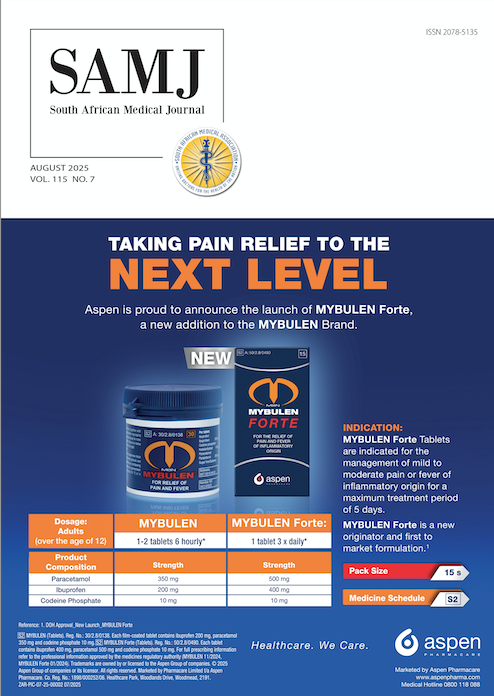Penicillin remains an effective agent against Group A Streptococcus in low- and middle-income countries: A systematic review and meta-analysis of antibiotic resistance and associated genes
DOI:
https://doi.org/10.7196/SAMJ.2025.v115i7.2837Keywords:
Group A Streptococcus, antimicrobial resistance, Antimicrobial resistance genes, LMICAbstract
Background. Driven by the extensive use of antibiotics, antibiotic resistance has become an issue globally, in both hospital and community settings. Limited access to laboratory diagnostic testing often results in undetected resistance, which may only be detected once empiric treatment fails. There have been numerous reports on the increase of antibiotic resistance in group A Streptococcus (Strep A), particularly macrolide resistance.
Objectives. To document the prevalence of antibiotic resistance in Strep A in low- and middle-income countries (LMICs) to the most widely used antibiotics. Where possible, resistance data were correlated with emm typing data.
Methods. We employed an extensive search strategy to identify studies in LMICs reporting on Strep A susceptibility to commonly prescribed antibiotics. Inclusion criteria required that isolates underwent emm typing. Two reviewers independently extracted data and assessed quality; statistical analyses, including meta-analysis using Stata software, evaluated the association between AMR and emm subtypes, and heterogeneity was assessed with Cochrane’s Q and I2 statistics.
Results. Fifty studies met the eligibility criteria and were included in this review. A range of phenotypic resistance testing methods was employed across the studies, the most common being disc diffusion. Three studies exclusively used molecular testing. For the Strep A antimicrobial resistance (AMR) quantitative synthesis, 23 commonly used antibiotics were included in the meta-analysis. Increased resistance was observed among the macrolides (erythromycin, clindamycin, azithromycin), clarithromycin and tetracycline. Differences were observed in resistance patterns across emm types, with emm1, emm12 and emm60 showing higher resistance rates to tetracycline and erythromycin. The ermB (57.60%) and tetM (52.18%) genes were the most prevalent AMR genes among the studies. No resistance to penicillin, amoxicillin/clavulanic acid, cefotaxime, cefuroxime, linezolid, ofloxacin or teicoplanin was reported.
Conclusion. This review comprehensively characterises the latest evidence on the prevalence of antibiotic resistance in Strep A in LMICs. Strep A in LMICs continues to be highly susceptible to antibiotics in vitro, primarily to penicillins. Strep A macrolide resistance patterns in LMICs are similar to those observed in high-income countries. The findings of this review may serve to inform effective treatment decisions and public health interventions.
References
1. Sanyahumbi AS, Colquhoun S, Wyber R, Carapetis JR. Global disease burden of group A Streptococcus. In: Ferretti JJ, Stevens DL, Fischetti VA, eds. Streptococcus pyogenes: Basic Biology to Clinical Manifestations. Oklahoma City: University of Oklahoma Health Sciences Center, 2016. https://www.ncbi.nlm.nih.gov/books/NBK333415/ (accessed 26 June 2025).
2. Carapetis JR, Steer AC, Mulholland EK, Weber M. The global burden of group A streptococcal diseases. Lancet Infect Dis 2005;5(11):685-694. https://doi.org/10.1016/s1473-3099(05)70267-x
3. Steer AC, Carapetis JR. Prevention and treatment of rheumatic heart disease in the developing world. Nature Rev Cardiol 2009;6(11):689-698. https://doi.org/10.1038/nrcardio.2009.162
4. Stockmann C, Ampofo K, Hersh AL, et al. Evolving epidemiologic characteristics of invasive group a streptococcal disease in Utah, 2002-2010. Clin Infect Dis 2012;55(4):479-487. https://doi.org/10.1093/ cid/cis422
5. Tenover FC. Mechanisms of antimicrobial resistance in bacteria. Am J Med 2006;119(6):S3-S10.
https://doi.org/10.1016/j.amjmed.2006.03.011
6. Peter G. Streptococcal pharyngitis: Current therapy and criteria for evaluation of new agents. Clin Infect Dis 1992;14(Supplement_2):S218-S223. https://doi.org/10.1093/clinids/14.Supplement_2.S218 7. Klein EY, Van Boeckel TP, Martinez EM, et al. Global increase and geographic convergence in
antibiotic consumption between 2000 and 2015. Proc Nat Acad Sci 2018;115(15):E3463-E3470. https://
doi.org/10.1073/pnas.1717295115
8. Berbel D, González-Díaz A, López de Egea G, Càmara J, Ardanuy C. An overview of macrolide resistance in streptococci: Prevalence, mobile elements and dynamics. Microorganisms 2022;10(12):2316. https://doi.org/10.3390/microorganisms10122316
9. White BP, Siegrist EA. Increasing clindamycin resistance in group A streptococcus. Lancet Infect Dis 2021;21(9):1208-1209.
10. Ayer V, Tewodros W, Manoharan A, Skariah S, Luo F, Bessen DE. Tetracycline resistance in group A streptococci: Emergence on a global scale and influence on multiple-drug resistance. Antimicrob Agents Chemother 2007;51(5):1865-1868. https://doi.org/10.1128/aac.01341-06
11. O’Neill J. Tackling drug-resistant infections globally: final report and recommendations. 2016.
12. World Health Organization. 10 global health issues to track in 2021. Geneva: WHO, 2020. https:// www.who.int/news-room/spotlight/10-global-health-issues-to-track-in-2021 (accessed 26 June 2025). 13. Fyfe C, Grossman TH, Kerstein K, Sutcliffe J. Resistance to macrolide antibiotics in public health pathogens. Cold Spring Harbor Perspect Med 2016;6(10):a025395. https://doi.org/10.1101/
cshperspect.a025395
14. Kataja J, Huovinen P, Skurnik M, Seppälä H. Erythromycin resistance genes in group A streptococci in Finland. Finnish Study Group for Antimicrobial Resistance. Antimicrob Agents Chemother 1999;43(1):48-52. https://doi.org/10.1128/AAC.43.1.48
15. Leclercq R. Mechanisms of resistance to macrolides and lincosamides: nature of the resistance elements and their clinical implications. Clin Infect Dis 2002;34(4):482-492. https://doi.org/10.1086/324626
16. Tatsuno I, Isaka M, Masuno K, Hata N, Matsumoto M, Hasegawa T. Functional predominance of
msr (D), which is more effective as mef (A)-associated than mef (E)-associated, over mef (A)/mef (E) in macrolide resistance in Streptococcus pyogenes. Microb Drug Resistance 2018;24(8):1089-1097. https://doi.org/10.1089/mdr.2017.027
17. Iannelli F, Santoro F, Santagati M, et al. Type M resistance to macrolides is due to a two-gene efflux transport system of the ATP-binding cassette (ABC) superfamily. Front Microbiol 2018;9(X:1670. https://doi.org/10.3389/fmicb.2018.01670
18. Brouwer S, Rivera-Hernandez T, Curren BF, et al. Pathogenesis, epidemiology and control of Group A Streptococcus infection. Nature Rev Microbiol 2023;21(7):431-447. https://doi.org/10.1038/s41579- 023-00939-6
19. Iskandar K, Molinier L, Hallit S, et al. Surveillance of antimicrobial resistance in low-and middle- income countries: A scattered picture. Antimicrob Resista Infect Control 2021;10(X):1-19. https://doi. org/10.1186/s13756-021-00931-w
20. Godman B, Egwuenu A, Wesangula E, et al. Tackling antimicrobial resistance across sub-Saharan Africa: Current challenges and implications for the future. Expert Opin Drug Safety 2022;21(8):1089- 1111. https://doi.org/10.1080/14740338.2022.210636821. Elton L, Thomason MJ, Tembo J, et al. Antimicrobial resistance preparedness in sub-Saharan African countries. Antimicrob Resist Infect Cont 2020;9(145):1-11. https://doi.org/10.1186/s13756-020- 00800-y
22. Nweneka CV, Tapha-Sosseh N, Sosa A. Curbing the menace of antimicrobial resistance in developing countries. Harm Reduction J 2009;6(31):1-4. https://doi.org/10.1186/1477-7517-6-31
23. Page MJ, McKenzie JE, Bossuyt PM, et al. The PRISMA 2020 statement: An updated guideline for reporting systematic reviews. BMJ 2021;X(X):372:n71. https://doi.org/10.1136/bmj.n71c
24. Munn Z, Moola S, Lisy K, Riitano D, Tufanaru C. Methodological guidance for systematic reviews of observational epidemiological studies reporting prevalence and cumulative incidence data. JBI Evidence Implement 2015;13(3):147-153. https://doi.org/10.1097/XEB.0000000000000054
25. Ouzzani M, Hammady H, Fedorowicz Z, Elmagarmid A. Rayyan – a web and mobile app for systematic reviews. Systematic Rev 2016;5(21):1-10. https://doi.org/10.1186/s13643-016-0384-4
26. Hoy D, Brooks P, Woolf A, et al. Assessing risk of bias in prevalence studies: Modification of an existing tool and evidence of interrater agreement. J Clin Epidemiol 2012;65(9):934-939. https://doi. org/10.1016/j.jclinepi.2011.11.014
27. Salie T, Engel K, Moloi A, Muhamed B, Dale JB, Engel ME. Systematic review and meta-analysis of the prevalence of group A Streptococcal emm clusters in Africa to inform vaccine development. Msphere 2020;5(4):e00429-20. https://doi.org/10.1128/mSphere.00429-20
28. Barendregt JJ, Doi SA, Lee YY, Norman RE, Vos T. Meta-analysis of prevalence. J Epidemiol Community Health 2013;67(11):974-978. https://doi.org/10.1136/jech-2013-203104
29. DerSimonian R, Laird N. Meta-analysis in clinical trials. Control Clin Trials 1986;7(3):177-188.
https://doi.org/10.1016/0197-2456(86)90046-2
30. Higgins JP, Thompson SG, Deeks JJ, Altman DG. Measuring inconsistency in meta-analyses. BMJ 2003;327(7414):557-560. https://doi.org/10.1136/bmj.327.7414.557
31. Migliavaca CB, Stein C, Colpani V, et al. Meta‐analysis of prevalence: I2 statistic and how to deal with heterogeneity. Res Synth Method 2022;13(3):363-367. https://doi.org/10.1002/jrsm.1547
32. Tadesse BT, Ashley EA, Ongarello S, et al. Antimicrobial resistance in Africa: A systematic review. BMC Infect Dis 2017;17(616):1-17. https://doi.org/10.1186/s12879-017-2713-1
33. Chochua S, Metcalf BJ, Li Z, et al. Population and whole genome sequence based characterisation of invasive group A streptococci recovered in the United States during 2015. MBio 2017;8(5):1110-1128. https://doi.org/10.1128/mbio.01422-17
34. Jing H-b, Ning B-a, Hao H-j, et al. Epidemiological analysis of group A streptococci recovered from patients in China. J Med Microbiol 2006;55(8):1101-1107. https://doi.org/10.1099/jmm.0.46243-0
35. Dhanda V, Chaudhary P, Toor D, Kumar R, Chakraborti A. Antimicrobial susceptibility pattern
of beta-haemolytic group A, C and G streptococci isolated from North India. J Med Microbiol
2013;62(3):386-393. https://doi.org/10.1099/jmm.0.046672-0
36. Ray D, Saha S, Sinha S, Pal NK, Bhattacharya B. Molecular characterisation and evaluation of
the emerging antibiotic-resistant Streptococcus pyogenes from eastern India. BMC Infect Dis
2016;16(753):1-11. https://doi.org/10.1186/s12879-016-2079-9
37. Silva-Costa C, Friaes A, Ramirez M, Melo-Cristino J. Macrolide-resistant Streptococcus pyogenes:
Prevalence and treatment strategies. Expert Rev Anti-Infective Ther 2015;13(5):615-628. https://doi.
org/10.1586/14787210.2015.1023292
38. Palmieri C, Vecchi M, Littauer P, Sundsfjord A, Varaldo PE, Facinelli B. Clonal spread of macrolide- and tetracycline-resistant [erm (a) tet (o)] emm 77 Streptococcus pyogenes isolates in Italy and Norway. Antimicrob Agents Chemother 2006;50(12):4229-4230. https://doi.org/10.1128/aac.00943-06
39. Seppala H. The effect of changes in the consumption of macrolide antibiotics on erythromycin resistance in group A streptococci in Finland: Finnish Study Group for Antimicrobial Resistance. N Engl J Med 1997;337(7):441-446. https://doi.org/10.1056/NEJM199708143370701
40. Brenciani A, Bacciaglia A, Vecchi M, Vitali LA, Varaldo PE, Giovanetti E. Genetic elements carrying erm (B) in Streptococcus pyogenes and association with tet (M) tetracycline resistance gene. Antimicrob Agents Chemother 2007;51(4):1209-1216. https://doi.org/10.1128/aac.01484-06
41. Ercole S, Petrelli D, Prenna M, et al. Distribution of mef (A)-containing genetic elements in erythromycin-resistant isolates of Streptococcus pyogenes from Italy. Clin Microbiol Infect 2005;11(11):927-930. https://doi.org/10.1111/j.1469-0691.2005.01250.x
42. Bingen E, Fitoussi F, Doit C, et al. Resistance to macrolides in Streptococcus pyogenes in France in pediatric patients. Antimicrob Agents Chemother 2000;44(6):1453-1457. https://doi.org/10.1128/ aac.44.6.1453-1457.2000
43. Michos AG, Bakoula CG, Braoudaki M, et al. Macrolide resistance in Streptococcus pyogenes: Prevalence, resistance determinants, and emm types. Diagnostic Microbiol Infect Dis 2009;64(3):295- 299. https://doi.org/10.1016/j.diagmicrobio.2009.03.004
44. Billal DS, Hotomi M, Yamauchi K, et al. Macrolide-resistant genes of Streptococcus pyogenes isolated from the upper respiratory tract by polymerase chain reaction. J Infect Chemother 2004;10(2):115-120. https://doi.org/10.1007/s10156-004-0302-X
45. Vitali LA, Di Luca MC, Prenna M, Petrelli D. Correlation between genetic features of the mef (A)- msr (D) locus and erythromycin resistance in Streptococcus pyogenes. Diagnostic Microbiol Infect Dis 2016;84(1):57-62. https://doi.org/10.1016/j.diagmicrobio.2015.08.007
46. Malhotra-Kumar S, Lammens C, Piessens J, Goossens H. Multiplex PCR for simultaneous detection of macrolide and tetracycline resistance determinants in streptococci. Antimicrob Agents Chemother 2005;49(11):4798-4800. https://doi.org/10.1128/aac.49.11.4798-4800.2005
47. Schroeder CM, Zhao C, DebRoy C, et al. Antimicrobial resistance of Escherichia coli O157 isolated from humans, cattle, swine, and food. Applied Environmental Microbiol 2002;68(2):576-581. https:// doi.org/10.1128/AEM.68.2.576-581.2002
48. Gebre AB, Fenta DA, Negash AA, Hayile BJ. Prevalence, Antibiotic susceptibility pattern and associated factors of Streptococcus pyogenes among pediatric patients with acute pharyngitis in Sidama, southern Ethiopia. Int J Microbiol 2024;2024:9282571. https://doi.org/10.1155/2024/9282571
49. Edrees WH, Anbar AAM. Prevalence and antibiotic susceptibility of Streptococcus pyogenes isolated from schoolchildren in Sana’a City, Yemen. PSM Veterinary Research 2021;6(2):22-30. https://www. psmjournals.org/index.php/vetres/article/view/575 (accessed 26 June 2025).
50. Muhtarova A, Mihova K, Markovska R, Mitov I, Kaneva R, Gergova R. Molecular emm typing of Bulgarian macrolide-resistant Streptococcus pyogenes isolates. Acta Microbiol Immunologica Hungarica 2020;67(1):14-17. https://doi.org/10.1556/030.66.2019.033
51. Tanaka Y, Gotoh K, Teramachi M, et al. Molecular epidemiology, antimicrobial susceptibility, and characterisation of macrolide-resistant Streptococcus pyogenes in Japan. J Infect Chemother 2016;22(11):727-732. https://doi.org/10.1016/j.jiac.2016.06.013
52. Albertí S, García-Rey C, Domínguez MA, et al. Survey of emm gene sequences from pharyngeal Streptococcus pyogenes isolates collected in Spain and their relationship with erythromycin susceptibility. J Clin Microbiol 2003;41(6):2385-2390. https://doi.org/10.1128/jcm.41.6.2385- 2390.2003
Downloads
Published
Issue
Section
License
Copyright (c) 2025 K Rampersadh, T Salie, K Engel, C Moodley, M Engel

This work is licensed under a Creative Commons Attribution-NonCommercial 4.0 International License.
Licensing Information
The SAMJ is published under an Attribution-Non Commercial International Creative Commons Attribution (CC-BY-NC 4.0) License. Under this license, authors agree to make articles available to users, without permission or fees, for any lawful, non-commercial purpose. Users may read, copy, or re-use published content as long as the author and original place of publication are properly cited.
Exceptions to this license model is allowed for UKRI and research funded by organisations requiring that research be published open-access without embargo, under a CC-BY licence. As per the journals archiving policy, authors are permitted to self-archive the author-accepted manuscript (AAM) in a repository.
Publishing Rights
Authors grant the Publisher the exclusive right to publish, display, reproduce and/or distribute the Work in print and electronic format and in any medium known or hereafter developed, including for commercial use. The Author also agrees that the Publisher may retain in print or electronic format more than one copy of the Work for the purpose of preservation, security and back-up.





